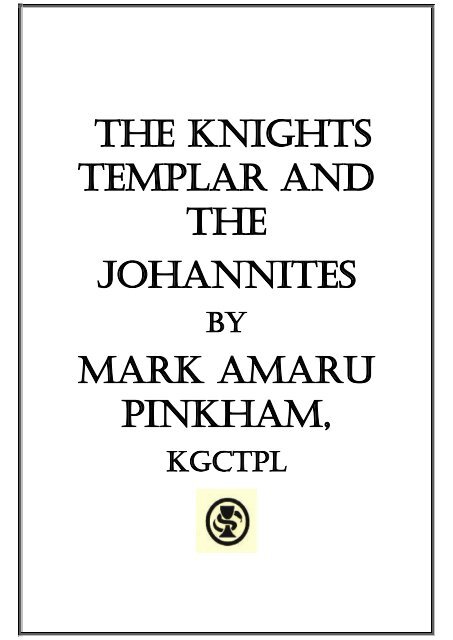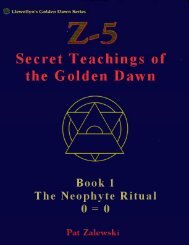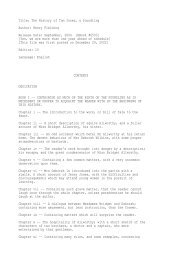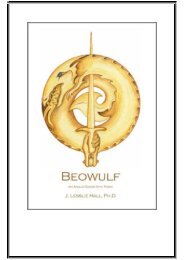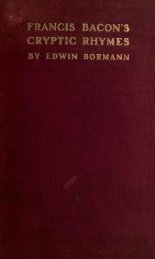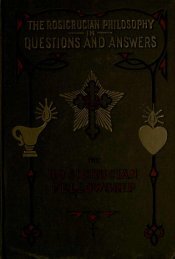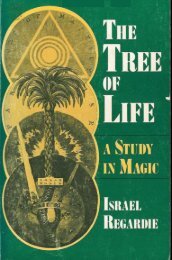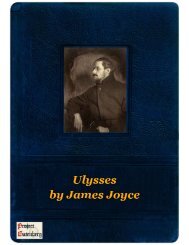download PDF version: 651KB - Global Grey
download PDF version: 651KB - Global Grey
download PDF version: 651KB - Global Grey
You also want an ePaper? Increase the reach of your titles
YUMPU automatically turns print PDFs into web optimized ePapers that Google loves.
The KnighTs<br />
Templar and<br />
The<br />
JohanniTes<br />
BY<br />
marK amaru<br />
pinKham,<br />
KgCTpl
Knights Templar And The Johannites By Mark Amaru<br />
Pinkham. This web edition published by <strong>Global</strong> <strong>Grey</strong> 2012.<br />
This work is licensed under a Creative Commons Licence. You are<br />
free: to copy, distribute, display, and perform the work, and to<br />
make derivative works under the following conditions: you must<br />
attribute the work in the manner specified by the licensor; you<br />
may not use this work for commercial purposes; if you alter,<br />
transform, or build upon this work, you may distribute the<br />
resulting work only under a license identical to this one. For any<br />
reuse or distribution, you must make clear to others the license<br />
terms of this work. Any of these conditions can be waived if you<br />
get permission from the licensor. Your fair use and other rights<br />
are in no way affected by the above.<br />
GLOBAL GREY<br />
NOTHING BUT E-BOOKS
1 Knights Templar And The Johannites By Mark Amaru Pinkham<br />
Soon after the Knights Templar were founded in 1118 AD Hughes de Payen became<br />
Grand Master of both the Templars as well as the Johannite Church, and some claim that<br />
he was even Grand Master of the Priory of Sion. The head of the Johannite Church at the<br />
time of the First Crusade was the Patriarch Theoclete. He was the 67 th Grand Master of<br />
a lineage of gnostic adepts that had begun with John the Apostle, all of whom acquired<br />
the titular name of “John” at their installation. Hugh de Payens was thus initiated into<br />
the lineage as John number 68. From that point onwards all the Templar Grand Masters<br />
technically assumed the titular name of John. But then the Knights’ mass arrest in 1307<br />
seemingly put an end to this lineage, or did it?<br />
In 1804 the world received an “update” regarding the Knights Templar and their<br />
Johannite Lineage via a doctor in France named Bernard Fabre-Palaprat. Fabre-Palaprat<br />
claimed that the neither the Knights nor their gnostic lineage ever ceased to exist, but<br />
simply became more clandestine and obscure after 1307. Once he had proclaimed<br />
himself the current Grand Master of the Johannite Lineage, Fabre-Palaprat was able to<br />
give credence to his claim by producing a list of all the Grand Masters of the line that<br />
had culminated with him. He also produced some Johannite documents that revealed<br />
that John the Apostle was the successor of a powerful gnostic lineage that Jesus had<br />
been initiated into. One such document was the Levitikon, which was the introduction to<br />
an ancient <strong>version</strong> of the Gospel of John called the Evangelikon. This document claimed<br />
that Jesus, after being initiated into the priesthood of Osiris in Egypt in the Great<br />
Pyramid and receiving prodigious power and gnostic wisdom from the Egyptian<br />
priesthood, passed on what all that he had received to John the Apostle.<br />
In order to give additional authority to his “new” Templar order, which he called the<br />
Johannite Church of Primitive Christians, Bernard Fabre-Palaprat was also able to<br />
produce the Larmenius Charter, which was a document that had been passed down the<br />
lineage of Johannite masters since the time of John Mark Larmenius, the successor of<br />
Jacques de Molay, and gave authority to its owners to found Templar preceptories in the<br />
tradition of the early Templars. But even before 1804 the Larmenius Charter had<br />
surfaced, when during a Templar Convention in Versailles in 1705 Philippe, the Duke of<br />
Orleans, was appointed as Grand-Master of the "Ordre du Temple" and became the head<br />
of a Templar preceptory in Orleans. Thus, Fabre-Palaprat’s announcement that he was<br />
in the possession of the Larmenius Charter and planned to continue the Templar<br />
tradition did not come as any great surprise to other informed French Templars.<br />
When Bernard Fabre-Palaprat founded the Johannite Church of Primitive Christians he<br />
claimed that some of the original Johannite-gnostic rites of the Templars had been lost<br />
and submitted that his intention was to reinfuse them into the Templar tradition. But<br />
ultimately Palaprat’s infusion led to a schism within the Templar organization. This<br />
occurred following Palaprat’s death in the mid 1800s, when the gnostic rites of the<br />
French Templars split off and merged with the Universal Gnostic Church (which<br />
eventually became known as the Johannite Church), while the military elements of<br />
Templarism evolved into the SMOTJ, The Sovereign Military Order of the Temple of<br />
Jerusalem, which today is principally a charitable organization comprised of military<br />
and ex-military members.<br />
Following Palaprat’s announcement regarding the Gnostic- Johannite history of the<br />
Templars, many esotericists of the period, including Madam Blavastky and Eliphas Levi,<br />
stepped forward to corroborate his story. Each confirmed that the Templars had indeed<br />
www.globalgrey.co.uk
2 Knights Templar And The Johannites By Mark Amaru Pinkham<br />
been Johannites and that Hughes de Payens had been initiated into the Johannite lineage<br />
by the Grand Master Theoclete. Blavatsky and Levi even claimed that the Templars were<br />
never truly Knights of the Pope but from their beginning they had been the Knights of<br />
St. John, with “St. John” referring to both John the Baptist and John the Apostle. Today, in<br />
order to conclusively prove the truth of these 19 th century esoteric historians,<br />
members of the contemporary Apostolic Johannite Church can produce a detailed<br />
lineage of Johannite Grand Masters that begins with John the Apostle, passes down a<br />
long lineage of Templar Grand Masters to Fabre- Palaprat, and ends with the present<br />
Primates of their Church.<br />
Within the last one-hundred years it has, however, become clear that the Johannite<br />
Lineage the Templars inherited is much more ancient than even John the Apostle and<br />
Jesus Christ. This wisdom began to circulate with the work of a woman named Lady<br />
Drower of England, who spent many years living in southern Iraq among the Mandeans,<br />
the only surviving Gnostic sect of antiquity who are known by many as the “People of<br />
John the Baptist.” According to the Mandeans, John the Baptist was born a Mandean and<br />
both raised and trained by the Nasurai, the spiritual adepts of their gnostic sect. The<br />
Mandeans refer to John as their last great prophet and maintain that he was a fully<br />
enlightened and empowered Nasurai priest. John passed the wisdom and power he had<br />
received from the Nasurai to Jesus, who in turn transmitted it to John the Apostle. Thus,<br />
according to Mandean history, the Johannite Lineage existed long before the time of<br />
either John the Apostle or John the Baptist and had passed down an ancient lineage of<br />
Nasurai adepts.<br />
According to Lady Drower, the origin of this lineage of Mandean Nasurai was the island<br />
paradise of Sri Lanka. In the Mandeans’ records she discovered that the entire sect had<br />
originally emerged out of Sri Lanka and then migrated west, eventually to Palestine.<br />
Today, Sri Lanka is to much of the world - not just the Mandeans- the original Garden of<br />
Eden and even contains Adam’s Peak, the mountain that God placed Adam in the Garden<br />
of Eden. Therefore, the Mandean records trace the sect all the way back to Eden. But this<br />
is not unusual for a gnostic sect do to, since through the ages the gnostic orders have<br />
tended to trace their Gnostic lineages back to the first gnostic teacher, the Serpent on<br />
the Tree, who was sent down by the gnostic Goddess Sophia to enlighten Adam and Eve.<br />
But the Serpent on the Tree is not just a fantasy or metaphor; in fact it is still<br />
worshipped in the Eden of Sri Lanka by priests and pilgrims in a temple town known as<br />
Kataragama. Here the infamous serpent is venerated in the form of both a snake and<br />
forever-young boy. The Hindus, Sri Lankans, Buddhists and Moslems who worship the<br />
Kataragama deity refer to this gnostic teacher as Murrugan, Sanat Kumara, Karttikeya,<br />
Subramaniya, Skanda and Jnana Pandita, meaning the “Teacher” and “Lord of Gnostic<br />
Wisdom.” The Sufis also know him as Al-Khadir, the “Initiator,” and the Hindus<br />
recognize him as the first Kundalini master on Earth, an Avatar, and the founder of the<br />
Siddha Marge, the Path to Perfection. Kundalini is the serpent power at the base of the<br />
spine that once awakened culminates in gnostic consciousness. Sanat Kumara, who was<br />
merged with or consumed by the Kundalini, initially existed on Earth in an etheric form<br />
or in a body of pure serpentine energy, which is why he is often depicted as a serpent on<br />
a tree. But according to many yogis of India, the tree in the Garden of Eden is both literal<br />
as well as symbolic, it is an actual tree but also symbolic of the human spine, which the<br />
yogis know as the Tree of Life. Similarly, the Serpent on the Tree in the Garden of Eden<br />
should thus be perceived as both an actual teacher of Gnosticism as well<br />
www.globalgrey.co.uk
3 Knights Templar And The Johannites By Mark Amaru Pinkham<br />
as a metaphor for the Kundalini serpent in your body that climbs the Tree of Life, your<br />
spine, in order to open your chakra centers and teach you gnostic wisdom.<br />
The Theosophists, whose center in Adyar, India, is right next to Mylapur, the place of<br />
Murrugan, received transmissions from members of the Great White Brotherhood<br />
instructing them that Sanat Kumara came from Venus with the Sons of God and was the<br />
original founder of their Brotherhood. The Sons of God landed on Lemuria, the larger,<br />
original size of the Garden of Eden, which was a continent that encompassed Sri Lanka<br />
and stretched across what is now the Pacific Ocean. The Sons of God mated with the<br />
Daughters of Men and then taught them divination, healing, astrology, and alchemy, the<br />
elements of modern day Goddess worship or what has become known as Wicca. The<br />
Sons of God came from the planet of the Goddess, Venus, with the Goddess’ wisdom of<br />
how to awaken and move energy, which is the first and purest form of the Goddess. The<br />
Sons of God had become Kundalini masters on their native planet and came to Earth to<br />
both establish schools for teaching the awakening of the power, as well as to transmit it<br />
directly into the Daughters of Men, thereby eventually passing it into the genetic gene<br />
pool of all humanity. Their schools eventually dispersed around the globe and became<br />
diverse branches of the Great White Brotherhood.<br />
Sri Lanka was still part of Lemuria as late as 30,000 years ago. At that time it was also<br />
connected to south India, so that spiritual teachers could travel overland between India<br />
and what is today Sri Lanka. One of Sanat Kumara’s disciples who completed this<br />
overland trek was Agastyar, a miniscule yogi who took the power of Sanat’s Gnostic<br />
lineage into India and through his students established many of the principal schools<br />
and lineages of yoga which still survive today. Another lineage of Kundalini masters<br />
founded by Sanat Kumara went westward. These were the Mandean Nasurai , a name<br />
which comes from Nass, meaning serpent, thus aligning them with the first teacher of<br />
Gnosticism and the serpentine Kundalini.<br />
In the records of the Mandeans studied by Lady Drower, it is said that after leaving Sri<br />
Lanka and migrating west the Mandeans became assimilated into a series of<br />
civilizations. They successively became part of the Sumerian, Egyptian, Persian and<br />
finally the Jewish culture. As part of the Jewish culture they were a sect of Essenes<br />
known as the Nasurai, Nasarene, or Nazarenes, i.e., the serpent sect. Two famous<br />
Mandean Nasurai, John the Baptist and Jesus, were born into the Nasarene sect of the<br />
Essenes. John the became the Grand Master of the Nasurai lineage in the west, before<br />
eventually passing the lineage to Jesus. Jesus in turn passed the lineage to his two<br />
beloved disciples. John the Apostle and Mary Magdalene. The contemporary Johannites<br />
believe that at least part of the transmission of Gnostic power and wisdom to these two<br />
disciples occurred during the Crucifixion, when Christ took his last breathe on the Cross.<br />
After this time we find John and Mary becoming patron and patroness of many Gnostic<br />
sects. Johns symbol, a chalice from which emerges a snake, symbolizes himself as the<br />
chalice or vessel full of the Kundalini serpent power.<br />
Following John and Mary the power of the Johannite lineage passed down a series of<br />
Grand Masters named John. It seems that the name John was never meant to be a name,<br />
but a title, meaning “He of Gnostic Power and Wisdom,” which is why the angel Gabriel<br />
insisted that the Baptist, who was full of the Holy Spirit or Kundalini power from his<br />
birth, be named John. The English John is apparently derived from the Sanscrit Jnana,<br />
the name of the “Serpent on the Tree” and first Grand Master of the Johannite<br />
www.globalgrey.co.uk
4 Knights Templar And The Johannites By Mark Amaru Pinkham<br />
lineage, Sanat Kumara. It appears that when the Mandeans took it west Jnana evolved<br />
into the Aramaic Yahya, the Hebrew Johanna, and then the English John.<br />
The Gnostic rites the Templars subsequently inherited from their Johannite Gnostic<br />
predecessors and then practiced in their preceptories Europe were eventually<br />
witnessed by the 12 spies of Philip the Fair of France who were sent into the Order to<br />
find heretical evidence against it. Once he felt he had ample evidence against the<br />
Knights King Philip had them arrested and tortured as heretics. The Templar rites that<br />
were spied upon and then became public knowledge included sacred kisses during<br />
initiations on the mouth and on those places upon the physical body associated in the<br />
East with Kundalini awakening. These practices could have been passed down directly<br />
to the Templars from the Johannite gnostic lineage, or they could have been learned<br />
from the Templars’ Sufi teachers who even today observe such practices. The Templars<br />
also practiced the gnostic rite of desecrating the cross by urinating and/or spitting upon<br />
it. This practice had already been observed by other Gnostic sects, such as the Cathars,<br />
and represented the gnostics’ hate of those patriarchal forces who had crucified the<br />
Christ on the cross. It had nothing to do with a dislike of Jesus, because, as mentioned,<br />
Jesus was a Grand Master of their Johannite lineage and therefore highly venerated by<br />
the Templars. He was, however, one rung below John the Baptist, the founder of the<br />
Johannite gnostic lineage in the west. This is why the Templars are also said to have<br />
“renounced” Christ and referred to John as their Savior. The Templars love of John<br />
included the veneration of a mummified head known as Baphomet. Most Templars and<br />
Templar related orders today agree that Baphomet not only represented John but was,<br />
in fact, the Baptist’s head, which had been discovered and captured during the 4 th<br />
Crusade when the Templars stormed and looted one of the palaces of Constantinople.<br />
The Templars are said to have entered a side chapel of the Burkoloin Palace which held<br />
incredible holy artifacts, including the cross, the shroud and the Head of John the<br />
Baptist. Apparently the head of John was still full of the Baptist’s Kundalini power even<br />
at that time because it is said that it helped to cure a Roman emperor of disease, and<br />
later during their depositions in front of the Inquisition the Templars claimed that is<br />
power could turn winter into spring and make flowers blossom. It appears that John’s<br />
head was eventually transported between the various preceptories by one of the high<br />
chiefs of the order, Hughes Piraud, and that it was only present during the highest<br />
initiations. This seems to be the only possible conclusion since only the high chiefs and<br />
initiates of the Order knew anything about it.<br />
The Templars’ gnostic rites may have also included sexual liaisons between the Knights.<br />
Homosexual sex had been a part of Gnostics sects almost since the time of their<br />
origination in the Middle East. The Bogomils, for example, were notorious for such acts.<br />
But it appears that the Knights were not just interested in the physical delight of such<br />
rites, because later in the 19 th century we find Aliester Crowley using these same<br />
practices to induce spiritual ecstasy and claiming they were descended from the<br />
Templars.<br />
But there is apparently definitive evidence that the Templars were involved with these<br />
practices. In 1780, a Danish Bishop found a document in the Vatican archives called<br />
Baptism of Fire of the Brothers-Consolate which was apparently the Secret Rule of the<br />
Templars. Supposedly written in the 13 th century, this document gave permission to<br />
the Templars to indulge in all manner of sexual rites, and it even allowed them to<br />
initiate new members from the gnostic Cathars, Bogomils and even the Assassins.<br />
www.globalgrey.co.uk
5 Knights Templar And The Johannites By Mark Amaru Pinkham<br />
Following their arrest and exile from France the Templars seem to have refrained from<br />
their hard core Gnostic and Tantric rites so as not to draw undue attention to<br />
themselves. However, they appear to have found ways to symbolically observe them<br />
within the new orders they became assimilated into. For example, it is known that some<br />
of the escaped Templars wandered into England and helped formulate the 13 degrees of<br />
the York Rite of Freemasonry, the last of which is known as the degree of Knight<br />
Templar. Although today they apparently use a sea shell when observing the rite of this<br />
degree, originally the candidate would drink out of a human skull while dedicating a<br />
toast to John the Baptist, whose head the skull represented. The Templars may have<br />
drunken out of the skull of John the Baptist or any number of human skulls they are<br />
ascribed of using in their gnostic rites. Even today such rites are common among the<br />
Tantric sects of India and Tibet. The Templars also incorporated their gnostic rites into<br />
the 33 degrees of the Scottish Rite of Freemasonry. There is, for example, an abundance<br />
of gnostic symbolism within the 17th and 18th degrees, the degrees of the Knight of<br />
East and West, and the Knight of the Rose Croix, and the Warden who initiates a new<br />
member into the gnostic 17 th degree is actually said to be playing the role of John the<br />
Baptist!<br />
When Fabre-Palaprat revived Johannite Templarism in the 19 th century he may have<br />
known of many of the knights’ Gnostic and sexual rites and made them part of what he<br />
called the High Initiation. Later, when Fabre-Palaprat’s order fell apart in the mid 1800s<br />
these gnostic rites were assimilated into the Universal Gnostic Church, which had been<br />
formed by Jules Dionel and his successor Jean Bricaud. This church was a synthesis of a<br />
number of Gnostic sects, including Fabre-Palaprat’s Johannites, as well as sects that had<br />
been founded by men calling themselves incarnations of Elijah or John the Baptist who<br />
stated that they had come to revive Gnosticism and herald the Age of the Paraclete, the<br />
Age of the Holy Spirit. In the late 1800s there was a sort of cross pollination between the<br />
Universal Gnostic Church and the OTO, the Oriental Templar Order. At that time the<br />
OTO acquired some of its sexual rites for the Gnostic Church, and it was these rites that<br />
it eventually became renown for. When Aliester Crowley became head of the OTO and<br />
began to experiment with the ancient Templar sexual rites, many of which were<br />
homosexual, he offered his gratitude to his Templar forebears. Crowley became so<br />
enamored over these Templar-gnostic rites that he eventually adopted the nickname of<br />
Baphomet.<br />
www.globalgrey.co.uk


